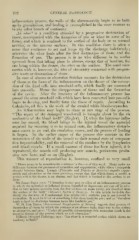Page 692 - My FlipBook
P. 692
702 GENERAL PATHOLOGY.
inflammatory process, the walls of the abscess-cavity begin to be built
up by granulations, and healing is accomplished in the same manner as
in any other breach of continuity.
An idccr'^ is a condition attended by a progressive destruction of
tissue, accompanied with the formation of pus or ichor in some of its
forms, and which is confined to the surface of the body or to natural
cavities, as the mucous surfaces. In this condition there is often a
cause that continues to act and keeps up the discharge indefinitely;
otherwise the ulcer heals after the first destruction of tissue and the
formation of pus. The process is in no wise different in its modus
operandi from that taking place in abscess, except that of location, the
one being within the tissues, the other on the surface. The word tdcer
carries with it, however, the idea of chronicity connected with progres-
sive waste or destruction of tissue.
In case of abscess or ulceration Strieker accounts for the destruction
of tissue at the focus of the inflammation on the theory of the conver-
sion of the fixed cells into amoeboid cells, which finally are converted
into pus-cells. Hence the disapi)carance of tissue and the formation
of the cavity. After the intensity of the inflammatory process has
passed the same amoeboid cells Avhicli have been converted into pus-cells
begin to develop, and finally form the tissue of repair. According to
Cohnhcim, all this is the work of the exuded white blood-corpuscles.
An inflammation may begin to abate at any stage of the process.
" The repair of the damaged vessel-wall is brought about by the vis
medicatrix of the blood itself" (Ziegler). If, when the injurious influ-
ence has ceased, the blood brings to the injured vessel the material
required for restoring it to its normal state, the inflammatory disturb-
ance comes to an end, the exudation ceases, and the process of healing
is begun. In the earlier stages of the process this consists in the
restoration of the walls of the vessels to their normal state of compara-
tive impenetrability, and the removal of the exudates by the lymphatics
and blood-vessels. If a small amount of tissue has been injured, it is
reproduced, the muscle-cell producing new muscle, periosteum produ-
cing new bone, and so on (Ziegler).
This manner of reproduction is, however, confined to very small
' There seems to be considerable confusion in the use of this word. Many make no
difference between the processes of ulceration and suppuration, while others distinguish
sharply between them. Loomis {Principles cuid Praclice of Medicine] regards suppu-
ration and ulceration as the same processes, except that that M'hicli forms a cavity, a
pocket within the tissues, is an abscess, and that which is limited to tlie surface is an
ulcer.
Sir .James Paget says: "Ulceration is that part or effect of an inflammatory process
in which the materials or inflamed tissues, liquefied or degenerate, are cast oli' in solu-
tion or very minute ]iarticles from the free surfaces, or, more rarely, are absorbed from
the suriVice of tlie body" (Hobnes'fi Sysiem nf Surgery). In this article beholds dis-
tinctly tlie doctrine (if I understand him aright) tiiat laudable pus is not foi'med in
ulceration. It nuist be ichor or something lower than laudable pus; and as "the ulcer
tends to heal its discharge becomes more like laudable jius."
W. H. Van Buren {International Eiiryclojicedia of Surgery) regards that process of
destruction of tissue by which the contents of an abscess make their way to the surface
as ulceration, and says : " Under all possible circumstances this molecular death is the
essential feature of the i)rocess which we call ulceration."
Billrotii (Surgical Patholoyy) says: "An ulcer is a wounded surface which shows no
tendency to lieal."


